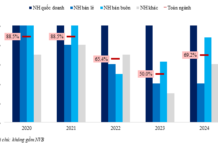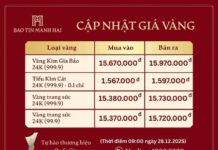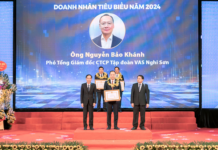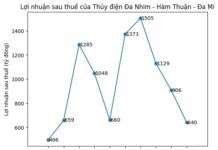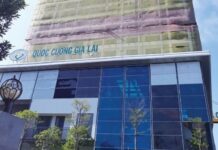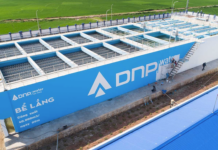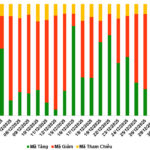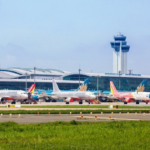5 2-lane expressways in Vietnam
Currently, Vietnam has 5 2-lane expressways with a total length of 371km: Cam Lo – La Son, La Son – Hoa Lien, Yen Bai – Lao Cai, Hoa Lac – Hoa Binh, Thai Nguyen – Cho Moi. The total investment for these 5 projects is about 52.935 trillion VND.
Cam Lo – La Son
After more than 2 years of construction, on December 31, 2022, the component project Cam Lo – La Son expressway with a length of 98.35 km (part of the project to build the Bac – Nam East-West Highway in the period of 2017-2022) was inaugurated.
This expressway is invested in phases. In the initial phase, with a scale of 2 lanes, the road width is 12m (the sections with overtaking lanes have a scale of 4 lanes and a road width of 23m). The complete phase has a scale of 4 lanes, with a road width of 23m. The project has a total investment of about 7.669 trillion VND, using government bond capital.

Cam Lo – La Son expressway. Photo: KTDT
The Cam Lo – La Son component project passes through two provinces of Thua Thien Hue and Quang Tri, connecting the economic and political centers of the two provinces, gradually completing the synchronized infrastructure, opening up many investment opportunities, and creating a premise for the socio-economic development of the two provinces.
La Son – Hoa Lien
The La Son – Tuy Loan expressway project started in December 2013, with a length of 77 km, a total investment of nearly 11.5 trillion VND in the form of BT contracts. Among them, the La Son – Hoa Lien section is 66 km long (part of the La Son – Tuy Loan project), 2 lanes, road width of 12m, design speed of 60 km/h, and has been put into operation.

La Son – Hoa Lien expressway. Photo: Bao Da Nang
This expressway starts from La Son junction (Phu Loc district, Thua Thien Hue province) to Hoa Lien intersection (Hoa Vang district, Da Nang city), contributes to reducing the load on National Highway 1A, expanding trade connections between Thua Thien Hue – Da Nang – Quang Ngai provinces, and promoting the socio-economic development of the central provinces.
Yen Bai – Lao Cai
The Noi Bai – Lao Cai expressway is one of the largest-scale expressway construction projects in our country, with a total length of 245 km, passing through Hanoi and provinces of Vinh Phuc, Phu Tho, Yen Bai, and Lao Cai.

Yen Bai – Lao Cai expressway. Photo: Bao Dau tu
This expressway with a length of 264 km has been put into operation since 2014, with 4 lanes for the Noi Bai – Yen Bai section and 2 lanes for the Yen Bai – Lao Cai section.
The total investment of the Noi Bai – Lao Cai expressway project is 1.46 billion USD (phase 1), equivalent to about 35.821 trillion VND.
The Vietnam Expressway Investment and Development Corporation (VEC) is currently urgently studying capital mobilization options and investment forms to continue expanding the Yen Bai – Lao Cai expressway to a scale of 4 lanes, to ensure synchronous exploitation with the Noi Bai – Yen Bai section and overcome existing limitations.
The total investment of the expanded Yen Bai – Lao Cai section is estimated at 8.74 trillion VND. Specifically, the investment in expanding 2 lanes to 4 lanes for the Yen Bai – Lao Cai section is 5.663 trillion VND; the investment in leveling sections and constructing 3 bridges for the Noi Bai – Yen Bai section is over 3.076 trillion VND.
Hoa Lac – Hoa Binh
According to the Planning for the Road Network for the period 2021 – 2030, with a vision to 2050, approved by the Prime Minister in Decision No. 1454/QD-TTg on September 1, 2021, the Hoa Lac (Hanoi) – Hoa Binh expressway, 32 km long, 6 lanes, investment process before 2030.

Hoa Lac – Hoa Binh expressway. Photo: VnEconomy
Currently, the Hoa Lac – Hoa Binh road is operated according to the standard width of 12m, including 2 lanes for motor vehicles and 2 lanes for mixed vehicles. The direction and geometric factors of the Hoa Lac – Hoa Binh road basically meet the requirements of the technical standard of expressways according to the plan. Initially, the total investment of the project was 6.745 trillion VND.
Thai Nguyen – Cho Moi
The Thai Nguyen – Cho Moi road is designed with 2 lanes for cars and 2 lanes for non-motorized vehicles, with a road width of 12m, a design speed of 80 km/h, and officially opened on January 31, 2017. The total investment for this road is over 2.7 trillion VND.

Thai Nguyen – Cho Moi road. Photo: TPO
Completing the 40km section from Thai Nguyen to Cho Moi will shorten the travel time from the center of Thai Nguyen city to Bac Kan to 1 hour instead of the previous 1 hour and 45 minutes when traveling via QL3.
Are 2-lane expressways a waste?
After a serious traffic accident on the Cam Lo – La Son expressway that claimed the lives of a mother and her two children, many drivers and traffic experts have had heated debates about 2-lane expressways without rigid barriers in Vietnam.
Explaining the reasons why some expressways are designed with limited 2 lanes, not different from national highways and provincial roads, the Ministry of Transport has stated that due to limited budgets, some expressway projects have been and are being invested in phases, and they will meet the scale according to the plan when completed.
Mr. Nguyen Xuan Thuy, former Director of the Transport Publishing House for Vietnamplus, said that many expressways in our country, including many sections of the Bac – Nam East-West Highway project, have not met the expressway standards due to the lack of sufficient investment. Specifically, they have only been built with 2 lanes.
“Due to the allocated funds not meeting the investment demand, the expressway infrastructure still has shortcomings such as narrow lanes, no emergency lanes… so a series of newly opened Bac – Nam Expressway sections are subject to speed restrictions, so they cannot be called expressways,” Mr. Thuy said in the above source.
Meanwhile, Assoc. Prof. Dr. Nguyen Quang Toan, former Head of the Road Department, University of Transport and Communications, told Suc Khoe & Doi Song that when a 2-lane expressway has to be upgraded and expanded to add lanes after only 5-10 years of being put into operation, it is a deficiency of both consultation and investment decision-makers. Upgrading an expressway and expanding lanes is extremely difficult and costly, not simple at all.
In Notice No. 29/TB-VPCP dated February 15, 2023, the conclusion of Prime Minister Pham Minh Chinh during the inspection and work on the implementation of key transport projects was that investment in 2-lane expressways should not be done.
Prime Minister Pham Minh Chinh emphasized that expressway planning must have a long-term, overall vision and a plan to invest and complete according to the expressway standards, not invest in limited 2-lane expressways, causing waste of resources and time for upgrading and expansion.
The Ministry of Transport has reviewed and reported to the Prime Minister on related issues and proposed solutions to soon invest in expanding and completing the operated expressways according to the phased scale, accelerate the completion of investment procedures to expand some sections from 2 lanes to 4 lanes and from 4 lanes to 6 lanes.






